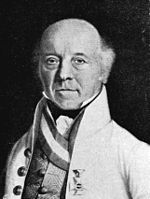Paul von Radivojevich
Paul von Radivojevich | |
|---|---|
| Born | 1759 Feldzeugmeister |
| Battles/wars |
|
| Awards | Inhaber Infantry Regiment Nr. 48Privy Councillor, 1816 |
Paul von Radivojevich (1759 – 15 July 1829) was an Austrian
Birth to 1809
Radivojevich was born into a family of
Promoted
1809 to 1814
Radivojevich was promoted to

Radivojevich's 10,000 troops were ordered to invade the

In October 1813, Radivojevich was appointed commander of the Left Wing Corps, which he would lead until the end of the 1814 campaign.
Because Radivojevich was forced to detach troops to mask the fortresses of Venice, Palmanova, and Osoppo, his weakened corps was unable to seriously threaten the Adige line. Even so, historian Frederick C. Schneid considered Radivojevich's movements "lethargic".[16] Meanwhile, Trieste surrendered to Nugent on 28 October after a 16-day siege.[17] When Hiller probed the Adige line near Verona, Eugène reacted by launching a counterattack. At 10:00 AM on 15 November, several Franco-Italian divisions assaulted the Austrian positions in the Battle of Caldiero. The Austrians were worsted, losing 1,500 killed and wounded plus 900 men and two cannons captured. The Franco-Italians lost only 500 killed and wounded[18] out of a total of 16,000. Radivojevich was in tactical control of 8,000 soldiers in 10 battalions, 11 squadrons, and nine artillery pieces. In the action, he directed one division led by Franz Mauroy de Merville and three brigades under Anton Gundaker von Starhemberg, Ludwig von Eckhardt, and August von Vécsey.[19]
Unhappy with Hiller's inability to chase Eugène out of Italy, the
1815 and later

During the
Frimont sent Bubna and the Piedmontese army west through the
After the fighting ended, Radivojevich took command of the Reserve Corps of the Army of Italy from July until October 1815, when he was briefly the acting army commander.
Notes
- ^ a b OeBL staff 1982, p. 377.
- ^ Smith 1998, p. 213.
- ^ Smith 1998, p. 216.
- ^ a b c d e Smith & Kudrna 2008, Radivojevich
- ^ Bowden & Tarbox 1980, p. 69.
- ^ Smith 1998, p. 322.
- ^ Schneid 2002, p. 196.
- ^ Schneid 2002, pp. 117–119.
- ^ Smith 1998, p. 447.
- ^ Smith 1998, p. 451-452.
- ^ Smith 1998, p. 454-455.
- ^ Smith 1998, p. 457.
- ^ Schneid 2002, pp. 121–122.
- ^ Schneid 2002, pp. 123–124.
- ^ Schneid 2002, p. 127.
- ^ Schneid 2002, p. 128.
- ^ Smith 1998, p. 473.
- ^ Schneid 2002, p. 129.
- ^ Smith 1998, gives Austrian killed and wounded as 500 (Smith 1998, p. 479).
- ^ Schneid 2002, p. 132.
- ^ Schneid 2002, p. 134.
- ^ Schneid 2002, p. 135.
- ^ Smith 1998, p. 493.
- ^ Schneid 2002, p. 135-138.
- ^ Schneid 2002, p. 157.
- ^ Schneid 2002, p. 158.
- ^ Schneid 2002, p. 206.
- ^ Schneid 2002, p. 158-160.
- ^ Hold 1875, pp. 133–134.
- ^ Smith & Kudrna 2008b, Simbschen.
- ^ Hold 1875, Appendix 37.
References
- Bowden, Scotty; Tarbox, Charlie (1980). Armies on the Danube 1809. Arlington, Texas: Empire Games Press.
- Hold, Alexander (1875). Geschichte des k. k. 48. Linien-Infanterie-Regimentes von siener zweiten Errichtung im Jahre 1798 an (in German). Vienna: Buchdruckerei von L. W. Seidel & Sohn. Retrieved 23 February 2013.
- Schneid, Frederick C. (2002). Napoleon's Italian Campaigns: 1805-1815. Westport, Conn.: Praeger Publishers. ISBN 0-275-96875-8.
- ISBN 1-85367-276-9.
- Smith, Digby; Kudrna, Leopold (August 2008). "Austrian Generals of 1792-1815: Paul von Radivojevich". napoleon-series.org. Retrieved 22 February 2013.
- Smith, Digby; Kudrna, Leopold (August 2008b). "Austrian Generals of 1792-1815: Joseph Anton von Simbschen". napoleon-series.org. Retrieved 23 February 2013.
- OeBL staff (1982) [1950]. "Radivojevich Paul Frh. von General". Österreichisches Biographisches Lexikon 1815-1950 (in German). Vol. 8 (online ed.). Austrian Academy of Sciences. p. 377.
